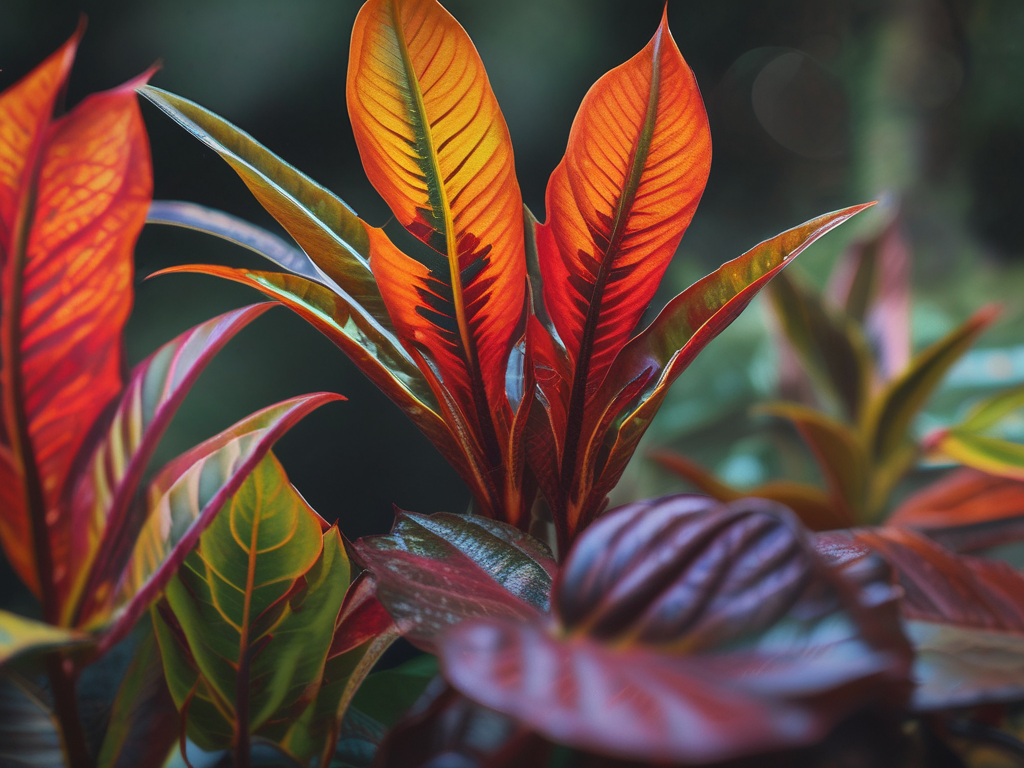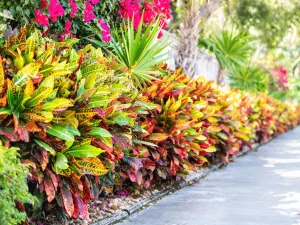Croton plants are a popular choice for many plant lovers due to their vibrant colors and striking leaves. These plants, known scientifically as croton codiaeum plant, come in various shapes, sizes, and colors, making them a favorite among indoor gardeners. Whether you’re interested in the croton petra plant, croton mammy plant, gold dust croton plant, banana croton plant, or the croton magnificent plant, there’s a croton variety for every style.
However, like any plant, crotons have their own specific care needs. In this guide, we’ll explore everything you need to know about croton plants, from how to care for them to common issues you might encounter.
Popular Croton Plant Varieties
Croton plants come in a variety of types, each with its own unique appearance. Here are some of the most popular croton plant varieties:
- Croton Petra Plant: This variety is known for its large, oval leaves with bright green, yellow, and red hues.
- Croton Mammy Plant: The mammy croton plant features twisted, narrow leaves that display a blend of green, red, purple, and yellow.
- Gold Dust Croton Plant: This plant has dark green leaves sprinkled with bright yellow spots, resembling gold dust.
- Banana Croton Plant: With long, narrow, banana-like leaves, this croton has a vibrant mix of green and yellow.
- Croton Magnificent Plant: True to its name, this variety has large, wavy leaves with a mix of green, yellow, red, and orange colors.
The Beauty of Pink Tulips: A Complete Guide to Planting and Caring
How to Care for a Croton Plant
Caring for a croton plant is relatively straightforward, but it’s important to understand their needs to keep them healthy and vibrant.
- Light: Croton plants thrive in bright, indirect sunlight. Too little light can cause the colors to fade, while too much direct sunlight can scorch the leaves.
- Water: It’s essential to keep the soil evenly moist but not waterlogged. Allow the top inch of soil to dry out before watering again.
- Humidity: Crotons love humidity. If you live in a dry area, consider misting your plant or using a humidifier to keep the air around it moist.
- Temperature: Keep your croton plant in a warm spot, ideally between 60-85°F (15-29°C). Avoid placing it near cold drafts or hot air vents.
How to Propagate a Croton Plant
If you want to grow more croton plants, propagation is a great way to do it. Here’s a simple guide on how to propagate a croton plant:
- Choose a Healthy Stem: Look for a healthy stem with at least three leaves.
- Cut the Stem: Using a clean, sharp knife or scissors, cut a 4-6 inch piece of stem just below a leaf node.
- Remove Lower Leaves: Remove the lower leaves to expose the nodes.
- Root in Water or Soil: Place the cutting in water or directly into a pot with moist soil. If rooting in water, change the water every few days. If rooting in soil, keep the soil moist but not soggy.
- Provide Proper Conditions: Keep the cutting in a warm, bright area, but out of direct sunlight. Roots should develop in a few weeks.
How to Prune a Croton Plant
Pruning is essential to encourage bushier growth and maintain the desired shape of your croton plant. Here’s how to do it:
- Trim Dead or Yellowing Leaves: Regularly remove any dead or yellowing leaves to keep the plant healthy.
- Cut Back Overgrown Branches: Trim overgrown branches back to a leaf node to encourage new growth.
- Use Clean Tools: Always use clean, sharp pruning shears to avoid spreading diseases.
Are Croton Plants Toxic?
Many people wonder, “are croton plants toxic to cats?” or “are croton plants toxic to dogs?” Yes, croton plants are considered toxic if ingested by pets or humans. The sap can cause skin irritation, and ingestion can lead to gastrointestinal issues. If you have pets or young children, keep croton plants out of reach.
Do Croton Plants Flower?
Yes, croton plants can produce small, insignificant flowers. However, they are primarily grown for their colorful foliage rather than their flowers. If you’re wondering, “do croton plants flower?” the answer is yes, but the blooms are usually not very noticeable or decorative.
Common Problems with Croton Plants
One common issue is leaf drop. If you find yourself asking, “why is my croton plant dropping leaves?” there are several possible reasons:
- Stress: Crotons are sensitive to changes in their environment. A sudden change in light, temperature, or humidity can cause leaf drop.
- Underwatering or Overwatering: Both can cause leaves to drop. Make sure you are watering correctly.
- Low Humidity: Crotons prefer a humid environment. If the air is too dry, the plant may shed its leaves.
How to Plant Croton Cuttings
If you want to grow new croton plants, here’s how to plant croton cuttings:
- Select a Pot: Choose a small pot with drainage holes.
- Prepare the Soil: Use a well-draining potting mix.
- Plant the Cutting: Insert the cutting into the soil, making sure the nodes are buried.
- Water: Water the cutting thoroughly and keep the soil moist.
- Provide Bright, Indirect Light: Place the pot in a bright, indirect light spot to encourage growth.

How to Take Care of a Croton Plant
Taking good care of your croton plant is key to keeping it healthy and colorful. Here’s a more detailed look at how to take care of croton plants:
- Soil: Croton plants prefer well-draining soil. A standard potting mix works well, but you can add perlite or sand to improve drainage. This is crucial because crotons don’t like to sit in soggy soil, which can lead to root rot.
- Fertilization: Crotons benefit from regular feeding. Use a balanced, water-soluble fertilizer every 4 to 6 weeks during the growing season (spring and summer). This will help maintain their vibrant foliage. In fall and winter, reduce feeding to once every 8 weeks.
- Pest Control: Like many indoor plants, crotons can be susceptible to pests such as spider mites, mealybugs, and scale. Check the undersides of leaves regularly for signs of infestation. If you find pests, treat them with insecticidal soap or neem oil.
- Repotting: Crotons typically need to be repotted every two to three years or when they outgrow their current pot. Choose a pot that is one size larger than the current one, and refresh the soil to provide new nutrients.
How to Prune a Croton Plant
Pruning your croton is not only about removing dead leaves. It also involves shaping the plant to encourage fuller growth. Here’s a step-by-step guide on how to prune a croton plant effectively:
- Identify What Needs to Be Pruned: Start by removing any dead or damaged leaves. These are usually brown or yellow and can be found at the base of the plant or among healthy leaves.
- Cut Back Leggy Growth: If your croton plant is becoming too tall or leggy, cut back the stems to just above a leaf node. This encourages the plant to branch out, leading to a bushier, more compact shape.
- Maintain the Plant’s Shape: Regularly trim the plant to maintain your desired shape. This not only keeps the plant looking good but also promotes better airflow around the leaves, which can help prevent pest infestations.
- Use the Right Tools: Always use clean, sharp scissors or pruning shears. This helps prevent the spread of diseases and makes cleaner cuts, which heal faster and more neatly.
How to Plant Croton Cuttings and Encourage Rooting
To propagate your croton plant, you’ll need to know how to plant croton cuttings effectively. Here’s a more detailed guide to ensure success:
- Select Healthy Cuttings: Choose a healthy stem that is free from disease and pests. It should be about 4-6 inches long and have several leaves attached.
- Prepare the Cuttings: Remove the lower leaves to expose at least two nodes. These nodes are where new roots will form.
- Rooting in Water: Place the cuttings in a jar of water, ensuring the nodes are submerged. Change the water every few days to prevent bacterial growth. Keep the jar in a warm, bright spot but out of direct sunlight. Roots should start to form in a few weeks.
- Rooting in Soil: Alternatively, you can plant the cuttings directly in soil. Dip the cut end in rooting hormone powder (optional) and place it in moist, well-draining soil. Cover the cutting with a plastic bag to create a humid environment and place it in indirect light. Check the soil regularly to ensure it remains moist.
- Transplanting: Once the cuttings have established roots about 1-2 inches long, they can be transplanted into individual pots with fresh potting soil.
Common Issues and Solutions for Croton Plants
Even with proper care, croton plants can sometimes encounter problems. Here are some common issues and their solutions:
- Dropping Leaves: If you notice that your croton plant is dropping leaves, it could be due to stress, such as a sudden change in temperature or humidity. Make sure your plant is in a stable environment with consistent light and humidity levels.
- Fading Colors: If your croton’s leaves are losing their vibrant colors, it might not be getting enough light. Move the plant to a brighter spot where it can receive plenty of indirect sunlight.
- Leaf Curling: Curling leaves can be a sign of underwatering. Check the soil moisture and water your plant if the top inch of soil feels dry.
- Pest Infestations: If you notice small, white, or brown pests on the leaves, your plant might have a pest problem. Treat it with insecticidal soap or neem oil and isolate it from other plants to prevent spreading.
Are Croton Plants Poisonous?
Many plant owners are concerned about the safety of their pets and family members around croton plants. To answer the question, are croton plants poisonous? Yes, they are. The plant’s sap can cause skin irritation, and ingestion of any part of the plant can lead to gastrointestinal distress in humans and pets.
- Are Croton Plants Toxic to Cats? Yes, croton plants are toxic to cats. If ingested, they can cause vomiting, drooling, and diarrhea. It’s important to keep croton plants out of reach of cats or choose pet-safe plants instead.
- Are Croton Plants Toxic to Dogs? Similarly, croton plants are toxic to dogs. Ingesting parts of the plant can lead to symptoms such as vomiting, drooling, and diarrhea. Always place croton plants in areas where dogs cannot access them.
Why is My Croton Plant Dropping Leaves?
One of the most common concerns for croton plant owners is leaf drop. If you’ve noticed your croton plant losing leaves, you may be asking, “Why is my croton plant dropping leaves?” There are several reasons why this might happen:
- Environmental Stress: Crotons are sensitive to changes in their environment. Moving a croton plant to a new location, changes in temperature, drafts, or even relocating it from indoors to outdoors (or vice versa) can cause stress, leading to leaf drop. To avoid this, try to maintain a stable environment with consistent temperatures and light levels.
- Watering Issues: Both overwatering and underwatering can cause leaves to drop. Croton plants need their soil to be consistently moist but not soggy. Overwatering can lead to root rot, which causes leaves to wilt and drop. Underwatering can cause the leaves to dry out and fall off. To find the right balance, let the top inch of soil dry out before watering again.
- Low Humidity: Crotons are tropical plants that thrive in high humidity. If your home has low humidity, especially during the winter months, the plant may start to drop leaves. To increase humidity, you can mist the plant regularly, place a humidifier nearby, or use a pebble tray filled with water.
- Pests and Diseases: Infestations by pests like spider mites or scale can stress the plant and cause leaf drop. Similarly, fungal or bacterial infections can damage leaves, leading them to fall off. Regularly inspect your croton for signs of pests and treat any issues promptly with insecticidal soap or neem oil.
How to Care for a Croton Plant in Different Seasons
Caring for a croton plant can vary slightly depending on the season, as these plants have different needs throughout the year.
- Spring and Summer: During the growing season, crotons are more active and will require more attention. Increase watering frequency to keep the soil consistently moist, as warmer temperatures can cause soil to dry out faster. This is also the best time to fertilize your croton plant every 4 to 6 weeks to promote healthy growth and vibrant foliage.
- Fall and Winter: In the cooler months, crotons enter a period of dormancy, and their growth slows down. Reduce watering frequency but don’t let the soil completely dry out. It’s also important to cut back on fertilizing during this time to prevent overfeeding. Make sure to keep your croton away from drafts and cold windows, as sudden drops in temperature can cause leaf drop.
Do Croton Plants Flower?
While croton plants are primarily grown for their stunning foliage, they can indeed produce flowers. If you’ve ever wondered, “do croton plants flower?”, the answer is yes, but the flowers are usually small and insignificant compared to the plant’s vibrant leaves.
- Flower Appearance: Croton flowers are typically small, white, and star-shaped, growing in clusters on long stalks. They are not particularly showy and do not have a strong fragrance, which is why they are often overlooked.
- Flowering Conditions: Croton plants may flower when they are healthy and thriving, especially in their natural habitat or in a well-maintained outdoor garden. However, indoors, flowering is less common. If you’re interested in encouraging flowers, ensure your plant is getting plenty of bright, indirect light and consistent care.
- Should You Trim Flowers?: Some gardeners choose to trim off the flowers to redirect the plant’s energy into leaf growth. If you prefer to focus on the foliage, you can remove the flower stalks as soon as they appear.
Tips for Keeping Your Croton Plant Vibrant
To keep your croton plant looking its best, follow these additional tips:
- Rotate the Plant: Croton plants grow towards the light, which can cause uneven growth. Rotate your plant every few weeks to ensure all sides receive equal light and grow uniformly.
- Dust the Leaves: Dust can accumulate on the leaves of indoor plants, blocking sunlight and reducing the plant’s ability to photosynthesize. Wipe the leaves gently with a damp cloth every few weeks to keep them clean and shiny.
- Check for Root Bound Issues: If your croton plant seems to have stunted growth or if the roots are circling the inside of the pot, it may be root-bound. Repotting into a slightly larger pot with fresh soil can give the roots more room to grow and improve overall plant health.
- Gradual Acclimation: If you need to move your croton plant to a different location or outdoors, do so gradually to help the plant acclimate. Start by placing it in its new location for just a few hours each day, gradually increasing the time over a week or two.


